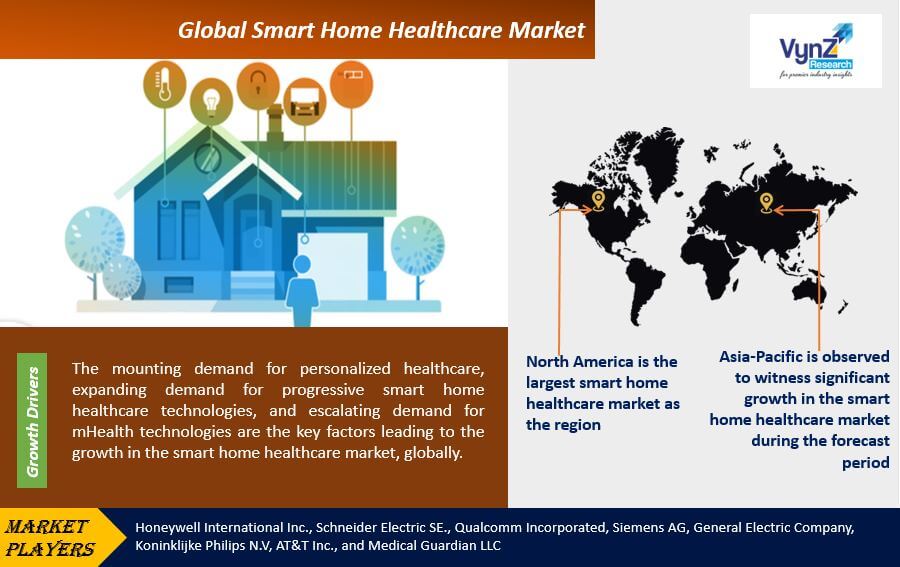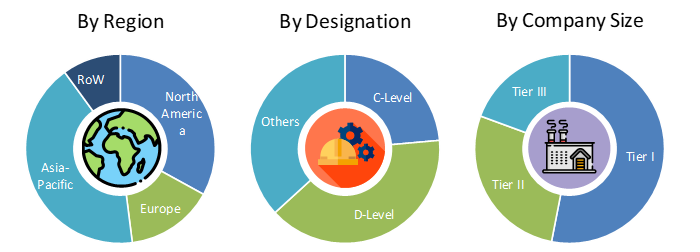| Status : Published | Published On : Dec, 2023 | Report Code : VRHC1108 | Industry : Healthcare | Available Format :

|
Page : 138 |

Global Smart Home Healthcare Market – Analysis and Forecast (2025-2030)
Industry Insights by Technology (Wireless Communication, Cellular Network, and Others), Service (Installation and Repair, and Customization and Renovation), and by Application (Safety and Security Monitoring, Memory Aids, Nutrition or Diet Monitoring, Fall Prevention and Detection, Health Status Monitoring and Others), and by Geography (U.S., Canada, Germany, U.K., France, China, Japan, India, and Rest of the World)
Industry Overview
The Global Smart Home Healthcare Market is predicted to grow at 33.2% CAGR during the forecast period with the market size reaching USD 38.6 billion by 2030. Different technologies such as wireless communication, a cellular network, and others as are majorly contributing to the smart home healthcare market size. The market has witnessed significant demand for the cellular network over the last few years due to its easy approachability by consumers and easiness of usage.

Smart home healthcare is designed to help in treatment diagnosis, care in the home. It helps in improving the communication between the caregivers and healthcare providers. Moreover, many health conditions, especially chronic diseases, could be monitored and treated in a home equipped with necessary smart home products.
Smart Home Healthcare Market Segmentation
Insight by Technology
Based on technology, the smart home healthcare market is classified into wireless communication, a cellular network, and others, of which cellular network hold the largest share in the smart home healthcare market, globally. Easy approachability by consumers and easiness of usage led to the fastest growth of the cellular network segment during the historical period, which is also predicted to continue during the forecast period.
Insight by Service
On the basis of the service, the smart home healthcare market is segmented into installation and repair, and customization and renovation. of all, the installation and repair category is predicted to witness the highest CAGR of during the forecast period and accounted the largest share in the smart home healthcare market due.
Insight by Application
On the basis of the application, the market is segmented into safety and security monitoring, memory aids, nutrition or diet monitoring, fall prevention and detection, health status monitoring and others. of all, the smart home healthcare market size for fall prevention and detection is expected to grow at the fastest rate during the forecast period, globally, and accounted for the largest share of the market.
Global Smart Home Healthcare Market Report Coverage
|
Report Metric |
Details |
|
Historical Period |
2018 - 2023 |
|
Base Year Considered |
2024 |
|
Forecast Period |
2025 - 2030 |
|
Market Size in 2024 |
U.S.D. xx.x Billion |
|
Revenue Forecast in 2030 |
U.S.D. 38.6 Billion |
|
Growth Rate |
33.2% |
|
Segments Covered in the Report |
By Technology, By Service and By End User |
|
Report Scope |
Market Trends, Drivers, and Restraints; Revenue Estimation and Forecast; Segmentation Analysis; Impact of COVID-19; Companies’ Strategic Developments; Market Share Analysis of Key Players; Company Profiling |
|
Regions Covered in the Report |
North America, Europe, Asia-Pacific, Middle East, South America and Rest of the World |
Industry Dynamics
Smart Home Healthcare Market Growth Drivers
The mounting demand for personalized healthcare, expanding demand for progressive smart home healthcare technologies, and escalating demand for mHealth technologies are the key factors leading to the growth in the smart home healthcare market, globally.
The prevalence of chronic diseases such as diabetes, cardiovascular conditions, and respiratory disorders is increasing. Smart home healthcare devices can help individuals monitor their health parameters and manage their conditions effectively, reducing the need for frequent hospital visits.
Owing to the mounting demand for personalized healthcare and escalating demand for advanced smart home healthcare has resulted in increased demand for mHealth technologies and Internet of things based monitoring systems, which further improve communication between patients and healthcare providers. Some of the other key factors driving the growth of the industry are expanding the geriatric population, escalating adoption of cloud technology in healthcare, and mounting disposable income. For instance, according to the World Health Organization (WHO), globally in 2010 approximately 524 million people were aged 65 years and older and is expected to reach 1.5 billion in 2050.
Smart Home Healthcare Market Challenges
Key factors hindering the growth of the smart home healthcare market are data safety and security issues, elevated capital expenditure and maintenance requirements, and limited awareness of smart home healthcare technologies in developing countries. In addition, the dearth of skilled professionals is also having a negative impact on the growth of the market.
Smart home healthcare devices collect and transmit sensitive patient data, including personal health information. Ensuring robust data privacy and security measures is crucial to protect patients' privacy and maintain their trust in the technology. Unauthorized access, data breaches, and the misuse of personal health data are significant concerns that need to be addressed.
Smart Home Healthcare Market Geographic Overview
Geographically, North America is the largest smart home healthcare market as the region the geriatric population is increasing. For instance, according to the U.S. Census Bureau, in 2012 approximately 43.1 million people were aged 65 years and older in the U.S., and is expected to reach 83.7 million in 2050.
In addition, enhanced healthcare infrastructure, the mounting occurrence of chronic and lifestyle-associated diseases, augmented alertness about inventive and advanced applications of smart home healthcare technologies, and escalating healthcare spending is also fueling the growth of the North American smart home healthcare market. For instance, according to the Centers for Disease Control and Prevention (CDC) in 2012, approximately 117 million people in the U.S. had one or more chronic conditions.
Asia-Pacific is observed to witness significant growth in the smart home healthcare market during the forecast period, as the region comprises a large population, and upsurge in IT investments in the healthcare industry. Moreover, expanding the geriatric population, escalating awareness about advanced and innovative applications of smart home-based wireless sensors and mounting occurrence of chronic and lifestyle-associated diseases are also facilitating the significant growth of the Asia-Pacific smart home healthcare industry.
Smart Home Healthcare Market Competitive Insight
Market players in the smart home healthcare industry are investing capital to develop technologically advanced systems.
Honeywell International Inc. is an American publicly traded, multinational conglomerate corporation headquartered in Charlotte, North Carolina. It primarily operates in four areas of business based on building automation, healthcare and technologies, aerospace, and safety and productivity solutions.
General Electric Company (GE) is an American multinational conglomerate founded in 1892, incorporated in the state of New York and headquartered in Boston. The company had several divisions, including , healthcare, aerospace, energy and finance.
Honeywell International Inc., Schneider Electric SE., Qualcomm Incorporated, Siemens AG, General Electric Company, Koninklijke Philips N.V., AT&T Inc., and Medical Guardian LLC are some of the key players offering solutions for smart home healthcare.
Recent Developments by Key Players
Medical Guardian has acquired MobileHelp from Advocate Aurora Enterprises to broaden its suite of health care solutions supporting aging adults with living independently and safely. The strategic acquisition bolsters Medical Guardian’s safety, engagement and wellness capabilities provided to more than 600,000 active members through its personal emergency response systems (PERS) and health care engagement services.
The Smart Home Healthcare Market report offers a comprehensive market segmentation analysis along with an estimation for the forecast period 2025–2030.
- By Technology
- Wireless Communication
- Cellular Network
- Others
- By Service
- Installation and Repair
- Customization and Renovation
- By End User
- Safety and Security Monitoring
- Nutrition/Diet Monitoring
- Memory Aids
- Fall Prevention and Detection
- Health Status Monitoring
- Others
Smart Home Healthcare Market by Region
- North America
- U.S.
- Canada
- Mexico
- Europe
- Germany
- U.K.
- France
- Italy
- Spain
- Rest of Europe
- Asia-Pacific
- Japan
- China
- India
- Australia
- South Korea
- Rest of Asia-Pacific
- Rest of the World
- Brazil
- South Africa
- Saudi Arabia
- U.A.E
- Rest of RoW
PRIMARY RESEARCH INTERVIEWS - BREAKDOWN

Frequently Asked Questions
Purchase Options
Latest Report
Research Methodology
- Desk Research / Pilot Interviews
- Build Market Size Model
- Research and Analysis
- Final Deliverabvle
Connect With Our Sales Team
- Toll-Free: 1 888 253 3960
- Phone: +91 9960 288 381
- Email: enquiry@vynzresearch.com
Smart Home Healthcare Market
